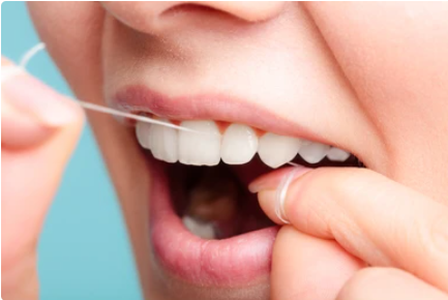Sachar Dental NYC
For SAME day / emergency appointments
Call (212) 752-1163
All the below content has been written by NYC Dentist, Dr. Sandip Sachar.
Flossing Your Teeth: How Often Should You Floss?
Brush your teeth twice a day (morning and night, for at least 2 minutes each time) and floss your teeth once a day (night is more common). Brush your teeth and then floss or floss your teeth and then brush. Either way is fine, says Dr Sachar.
The American Dental Association (ADA) recommends flossing at least once a day to maintain oral health. A study published in the Journal of Periodontology found that individuals who floss daily have significantly lower levels of gum inflammation compared to those who do not.
Skipping flossing can leave up to 40% of your tooth surfaces unclean! That is nearly half of your mouth potentially still harboring bacteria between your teeth and under your gums.
What is Flossing?
Flossing is a dental hygiene practice that involves the use of a thin string or thread, called dental floss, to scrape and clean between teeth and remove food particles, plaque, and bacteria that can cause cavities and gum disease.

The Importance of Flossing
When we eat food every day, food particles and plaque —a sticky film of bacteria—can accumulate between teeth and along the gumline. If not removed, plaque can harden into tartar or calculus, and both plaque and tartar can potentially lead to cavities and/or gum disease. Brushing teeth twice a day and flossing once a day is recommended for removing plaque and preventing gum disease and cavities. Additionally, research has shown a potential link between flossing and reduced risk of heart disease.
Which Floss is Best?
- Waxed vs. Unwaxed Floss: Waxed floss slides more easily between tight teeth, while unwaxed floss provides a better grip on plaque and is better for teeth with big gaps between them.
- Floss Picks: Floss picks are convenient and easy but may not clean as effectively as traditional floss. They are better than nothing though, says Dr Sachar.
- Interdental Brushes: Ideal for people with wider gaps between teeth.
- Water Flossers: Great for individuals with braces or dexterity issues.
How to Floss Correctly?
-
Cut about 18 inches of floss and grab a 2 inch piece of it tightly with two hands.
-
Gently slide the taut area of floss between your teeth.
-
When the floss reaches the gum line, wrap it against one tooth, forming a C shape, and slide it gently below the gum.
-
Keep the floss tight against the tooth. Move it up and down along the side of the tooth. Repeat this for the other tooth.
-
Then repeat for all your teeth, top and bottom while moving on to a clean piece of floss as you go. Don’t forget behind the last teeth at the very back of your mouth.
Floss Before or After Brushing Teeth?
The ADA suggests that flossing before or after brushing are both acceptable as long as both are done thoroughly.
Should Kids Floss?
Children should begin flossing as soon as they have two teeth that touch. Initially, parents should assist with flossing until the child develops the dexterity to do it independently, typically around age 10 or 11.
Flossing Mistakes to Avoid
- Snapping the floss into the gums, which can cause pain, irritation and bleeding.
-
Using the same section of floss for multiple teeth, which can spread bacteria or food particles.
- Skipping the back teeth or not flossing under the gumline thereby leaving plaque behind.
Flossing with Braces or a Dental Bridge:
- Use a floss threader to guide floss under the wire or bridge.
- Try orthodontic flossers designed for braces.
- Consider a water flosser for easy interdental cleaning.
Flossing and Overall Health
- Heart Health: Research links gum disease to an increased risk of heart disease.
- Diabetes Management: If your diabetes is not well-managed, you're at a higher risk of developing gum disease. Additionally, gum disease can make it more difficult to control your blood sugar levels.
- Respiratory Health: There is some research suggesting bacteria from gum infections may contribute to respiratory illnesses.
Frequently Asked Questions (FAQs)
No, flossing physically removes plaque, while mouthwash only kills bacteria.
Skipping flossing allows plaque buildup, increasing your risk of cavities, gum disease, and potential tooth loss over time from periodontal disease. If you are unable to floss it becomes even more important that you make sure to get your teeth cleaned professionally by a dentist every 3-6 months.
Use soft floss and apply gentle pressure to avoid irritation. If discomfort persists, consult your dentist.
Conclusion
Incorporating flossing into your daily oral hygiene routine is essential for maintaining healthy teeth and gums. By understanding the importance of flossing, selecting the right tools, and employing proper techniques, you can prevent dental issues and promote overall oral health.
Are You Concerned About Cavities or Bleeding Gums?
20 East 46th Street
Rm 1301
(Between 5th Ave & Madison Ave)
New York, NY 10017
212-752-1163
https://www.sachardental.com/
drsachar@sachardental.com